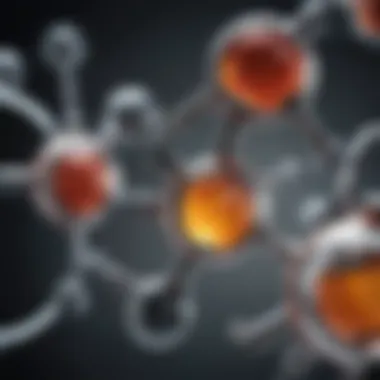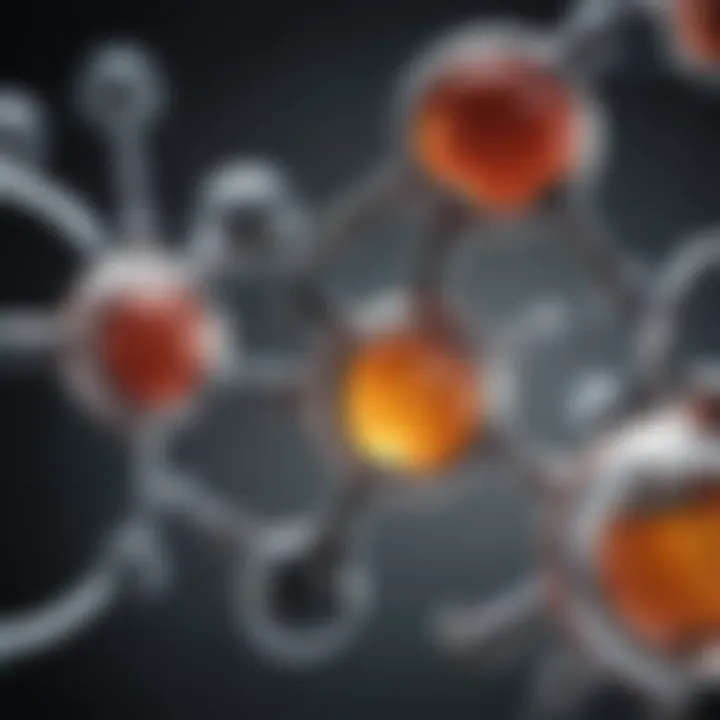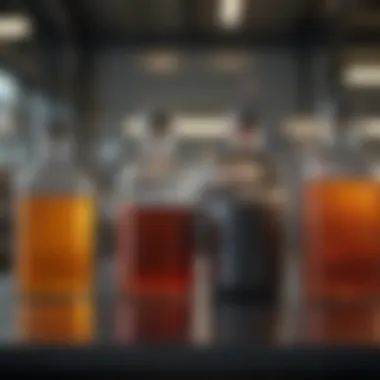The Importance of Oxidising Agents in Chemistry


Intro
When you think about chemical reactions, it's easy to focus on the reactants and products involved. However, there's a less visible player that often holds the key to how those reactions unfold: oxidising agents. Understanding their role can shed light on a host of chemical processes that shape the world around us.
Oxidising agents are substances that accept electrons and, in doing so, facilitate the oxidation of another substance. They are vital in various fields, including biochemistry, industrial manufacturing, and environmental sciences, functioning as catalysts and reactants alike. By exploring the nuances of oxidising agents, we can appreciate not just their function, but their broad implications in both exciting innovations and critical safety measures.
The journey ahead will take a closer look at the mechanisms behind oxidising agents, categorize their types, and highlight their applications in real-world scenarios. Along the way, we’ll also touch on the safety considerations that must be taken into account when employing these powerful agents.
Being informed about oxidising agents isn’t just for chemists—it’s essential for educators, researchers, and anyone keen on understanding the subtle dynamics of chemical reactions. Let's not just skim the surface, but dive into the depths of this fascinating topic.
Definition of Oxidising Agents
The term "oxidising agents" may seem like just a puzzle of scientific jargon, but it embodies a crucial concept in chemistry. At its core, an oxidising agent, or oxidant, is a substance that accepts electrons from another species during a chemical reaction. This donation of electrons, in simpler terms, results in the oxidation of that species while the oxidising agent itself gets reduced. Understanding this relationship is fundamental for grasping larger chemical processes; in fact, they lay the groundwork for various reactions, from biological systems to industrial applications.
When we think about oxidising agents, what's important is not merely their role but also their diversity and significance. These agents enable many reactions that produce energy, synthesize complex molecules, and even break down harmful substances. So whether it’s the way plants harness sunlight energy via photosynthesis or industries utilize chlorine in water purification, oxidising agents are pivotal.
Additionally, acknowledging the characteristics and behaviors of these agents offers insights into their practical applications. Each agent comes with its own set of chemical properties that dictate how it interacts with other substances. Understanding this can reveal the implications they have not just in a lab, but also in real-world scenarios, such as environmental remediation efforts or biomedical applications.
"Oxidizing agents are the linchpins of various reactions, acting quietly but profoundly in chemical landscapes."
Chemical Properties
Diving deeper into the chemical properties of oxidising agents reveals their complex yet fascinating nature. These properties include high electronegativity and the ability to stabilize higher oxidation states. For instance, substances like potassium permanganate (KMnO₄) and hydrogen peroxide (H₂O₂) are well-known oxidising agents, each with distinctive characteristics shaping their utility in different contexts.
Additionally, the chemical behavior can vary quite a bit based on their molecular structure. Some oxidising agents, like ozone (O₃), offer excellent oxidation potential due to their reactive oxygen molecules. Others, such as nitrous oxide (N₂O), show comparatively milder properties but can effectively support oxidation reactions under specific conditions. Understanding these properties aids chemists in selecting the right oxidising agent for a given reaction, making it easier to predict the reaction products and optimize conditions.
Moreover, it’s vital to consider the environment when discussing their properties. The reactivity of oxidising agents can markedly shift depending on pH levels, temperature, and the presence of other substances. Thus, controlling these factors often leads to more efficient reaction pathways, ensuring sustainable chemical processes.
Role in Oxidation-Reduction Reactions
Oxidation-reduction, or redox reactions, are the heart and soul of many chemical transformations, and the role of oxidising agents here is indispensable. In a redox process, as one substance gets oxidized, the oxidising agent assists by gaining electrons, promoting balance within the reaction framework. This is why understanding their role is not only about what they do, but also how they maintain the larger processes.
For example, when iron rusts, oxygen acts as the oxidizing agent, facilitating the oxidation of iron into iron oxides. Without oxygen, the transformation wouldn’t occur. Such connections highlight the critical nature of oxidising agents in myriad chemical pathways.
Additionally, redox reactions are not limited to mere transformations. They are essential for energy production, such as in cellular respiration where glucose oxidizes under the influence of oxygen to release energy. This gives a glimpse into how intertwined the existence of oxidising agents is with life itself.
By delving into these roles, we appreciate the dynamism and importance of oxidising agents in understanding chemical reactions as a whole. They are not just participants but key players that steer chemical processes in one direction or another, making their study vital for both theoretical and applied sciences.
Types of Oxidising Agents
Understanding the different types of oxidising agents is fundamental in the realm of chemistry. This knowledge not only provides clarity on how various agents function in reactions but also underlines their significance across multiple applications. Oxidising agents can be broadly classified into two main categories: inorganic and organic. Each type carries its own unique properties, mechanisms, and roles in different reactions, from simple lab experiments to complex industrial applications.
Inorganic Oxidising Agents
Inorganic oxidising agents are compounds that can accept electrons during a chemical reaction, facilitating oxidation of other substances. Notable examples of inorganic oxidisers include potassium permanganate (KMnO₄), hydrogen peroxide (H₂O₂), and nitric acid (HNO₃).
These agents often have the ability to undergo changes in their oxidation states, allowing them to participate in various reactions with high efficiency. For instance, potassium permanganate is known for its robust oxidising capabilities, particularly in acidic solutions where it transforms from MnO₄⁻ to Mn²⁺. This change not only highlights the agent’s function but also its adaptability in multiple chemical environments.
The benefits of using inorganic oxidising agents are plentiful. They tend to be cost-effective and are readily available, making them suitable for a wide range of applications, from water treatment processes to the synthesis of chemicals. However, handling these substances requires precautions as they can be hazardous.
"Inorganic oxidising agents can not only facilitate reactions but also present serious risks if mishandled. Proper safety protocols are crucial."
Organic Oxidising Agents
On the other hand, organic oxidising agents are characterized by their carbon-containing structures and are typically employed in more specialized chemical processes. Common examples include ozone (O₃), potassium dichromate (K₂Cr₂O₇), and certain peroxides like benzoyl peroxide.
These agents often serve unique roles in organic synthesis, including the oxidation of alcohols to ketones or aldehydes, which is a cornerstone reaction in synthetic organic chemistry. It's fascinating to note how, unlike their inorganic counterparts, some organic oxidisers operate under milder conditions, which can be highly advantageous in preserving sensitive functionality in complex molecules.
Organic oxidising agents, while less aggressive than some inorganic ones, still pose handling and environmental concerns. For instance, ozone is a powerful oxidant in the atmosphere but can be harmful at ground level. Therefore, awareness and understanding of the specific conditions under which these agents operate is crucial for their safe and effective use.


Key Mechanisms of Action
Understanding the key mechanisms of action of oxidising agents is central to grasping their role in a spectrum of chemical reactions. These mechanisms not only define how these agents interact with other molecules but also provide insights into their functionality and applications in various fields. It is their ability to modify the oxidation state of elements that truly drives many chemical changes. In this section, we will explore two of the main mechanisms: electron transfer processes and increasing oxidation states.
Electron Transfer Processes
At the heart of many chemical reactions involving oxidising agents is the phenomenon of electron transfer. In simple terms, this refers to the movement of electrons from one atom or molecule to another. Oxidising agents act by accepting electrons, thereby inducing the oxidation of other substances.
This process is often illustrated through redox reactions, where oxidation and reduction occur simultaneously. For instance, in the reaction between hydrogen peroxide and iodide ions, hydrogen peroxide acts as the oxidising agent. It gains electrons from iodide, which in turn loses electrons and is oxidised to iodine:
Oxidising agent: H₂O₂ + 2I⁻ → I₂ + 2OH⁻
Here, the ability of hydrogen peroxide to facilitate this transfer is crucial for understanding its broader applications, such as in disinfection and bleach formulations.
Besides its practical applications, mastering the concept of electron transfer also benefits students and professionals in fields ranging from organic chemistry to biochemistry. Recognizing the nuances of these electron exchanges can help forecast reaction outcomes, optimize reaction conditions, and design more effective experiments.
Increasing Oxidation States
Oxidising agents not only accept electrons but also play a pivotal role in raising the oxidation states of other species. The oxidation state is a key to understanding how substances engage with one another at a fundamental level. By facilitating the transfer of electrons and increasing oxidation states, these agents are responsible for a variety of chemical transformations.
To illustrate, consider the reaction involving potassium permanganate (KMnO₄) in acidic solutions. It can serve as a powerful oxidising agent:
- In a redox reaction: KMnO₄ transforms ferrous ions (Fe²⁺) into ferric ions (Fe³⁺), raising the oxidation state from +2 to +3.
This capability is essential in numerous applications, such as titrations in analytical chemistry, where accurate measurements of concentrations rely on precise oxidation state changes.
Understanding how oxidising agents elevate oxidation states allows scientists to tailor reactions for specific outcomes, creating pathways to synthesize complex molecules, which is vital for both research and industrial processes.
In summary, the mechanisms of action associated with oxidising agents are not merely academic concepts; they underpin a wide range of practical applications. Grasping these mechanisms enhances both comprehension and innovation across various scientific disciplines.
Applications in Chemistry
The realm of oxidising agents is nothing short of pivotal in the field of chemistry. Their application stretches across various domains, from the intricate synthesis of complex compounds to the critical evaluation of substances through analytical methods. Understanding how these agents operate in different chemical reactions not only enhances our comprehension of chemistry but also supports innovations in diverse fields. The benefits of utilizing oxidising agents are manifold, influencing both theoretical and practical approaches to chemical synthesis, analysis, and even environmental management.
Synthesis of Compounds
Oxidising agents are celebrated for their role in the synthesis of numerous chemical compounds, not least for their ability to promote reactions that are otherwise sluggish or unsupported by other means. A classic example can be seen in organic chemistry, where compound synthesis often relies on effective oxidation. Consider the synthesis of alcohols from carbonyl compounds. In this scenario, potassium permanganate acts as an oxidising agent to facilitate the transformation, allowing chemists to achieve their desired products with greater efficiency.
Using an oxidising agent can significantly lower activation energy requirements, thus making reactions more feasible. Moreover, the precision with which chemists can control oxidation states contributes to the selective formation of functional groups.
In industrial contexts, oxidising agents such as hydrogen peroxide are frequently employed in the manufacture of plastics and perfumes. They often initiate polymerization reactions, leading to materials with emerging properties. The importance of careful selection of oxidants cannot be overstressed; choosing the right agent can mean the difference between success and failure in chemical synthesis.
Analytical Chemistry Techniques
In analytical chemistry, oxidising agents shine through their applications in various techniques aimed at detecting and quantifying substances. One popular method is the titration process, where a known concentration of an oxidising agent is used to react with a sample of an unknown concentration. This kind of redox titration, utilizing agents like potassium dichromate, gives chemists a reliable means to ascertain oxidation states and concentrations of analytes.
Oxidising agents further play a role in spectrophotometric analyses, where they enhance the color reaction of certain compounds. For instance, when an oxidant interacts with specific analytes, it often changes the absorbance characteristics, allowing for more straightforward detection and measurement.
Oxidising agents not only assist in the synthesis of complex compounds but also serve as essential tools in the precise measurement and analysis of chemical substances.
In summary, whether it’s through facilitating synthesis processes or providing powerful analytical tools, the multifaceted applications of oxidising agents in chemistry serve to underline their significance in scientific research and industrial practices. Their versatility offers a wealth of opportunities for further exploration and application, promising continued advancements in various scientific disciplines.
Biological Significance
In the grand web of life, oxidising agents play a pivotal role that’s often overlooked. When we talk about biological reaction processes, understanding these agents is not just science jargon; it's about grasping how life sustains itself at the molecular level.
Role in Metabolism
Metabolism encompasses all the chemical reactions that occur within a living organism. Here, oxidising agents are indispensable. They facilitate the breakdown of complex molecules, leading to energy production, which fuels various biological activities. For instance, in aerobic respiration, oxygen acts as a key oxidising agent. It enables the breakdown of glucose into carbon dioxide and water while releasing energy stored in the glucose molecule. This energy is then harnessed to power cellular processes critical for life.
Moreover, the action of oxidising agents extends beyond mere energetic exchanges. They often help in the detoxification of harmful substances. Enzymes like cytochrome P450 utilize these agents to transform toxic compounds into less harmful forms, allowing for efficient waste removal. In this way, oxidising agents serve as biological clean-up crews, maintaining the overall health and functionality of cells.


Antimicrobial Properties
The antimicrobial properties of oxidising agents cannot be overstated. These substances have a remarkable ability to combat pathogens, making them vital in both medical and environmental contexts. Hydrogen peroxide, for example, is extensively used in disinfection due to its potent oxidising capability. When it comes into contact with microbial cells, it wreaks havoc by disrupting cellular structures through oxidation.
In a clinical setting, the application of oxidising agents has transformed disinfection protocols. When used judiciously, they not only kill bacteria and viruses effectively but also limit the development of resistance, a growing concern in modern medicine.
"In the fight against infections, the right oxidising agents provide a double whammy: effective destruction of harmful microbes while safeguarding healthy tissues."
Furthermore, their role isn't confined to hospitals or labs. In wastewater treatment, oxidising agents like ozone and chlorine help decompose organic matter and eliminate pathogens, ensuring a cleaner environment.
In summary, whether it’s metabolism or fighting infections, oxidising agents are unsung heroes in biological processes, paving the way for life’s complexities. Their significance stretches across various domains, underscoring the need for continued research to harness their properties effectively.
Industrial Applications
The role of oxidising agents in industrial applications is vast and multifaceted. Industries across various sectors depend on these compounds for processes that range from manufacturing to waste treatment. Understanding how oxidising agents function can lead to improved efficiencies, enhanced product quality, and compliance with environmental regulations. This part of the article delves into notable applications of oxidising agents and their significance in industrial settings.
Manufacturing Processes
In manufacturing, oxidising agents play a pivotal role. They are often employed in reactions that lead to the production of a host of chemicals indispensable in the production of polymers, pharmaceuticals, and many other substances. Some commonly used oxidising agents in manufacturing include chlorine, ozone, and hydrogen peroxide.
For instance, hydrogen peroxide is frequently used in the textile industry for bleaching purposes. It can effectively remove color from fabrics without damaging the fibers, which is a considerable advantage over traditional chlorine bleach. Additionally, in the synthesis of certain pharmaceuticals, oxidising agents are vital in forming precise chemical bonds that define the structure and functionality of drugs.
Furthermore, the efficiency of chemical manufacturing is often enhanced through the use of catalysis, where oxidising agents can influence reaction rates and pathways. This is important when it comes to maximizing yields while minimizing waste and by-product formation. Overall, the implementation of oxidising agents can streamline production lines and foster innovation in chemical synthesis.
Waste Treatment Solutions
The application of oxidising agents extends even into waste treatment solutions. These agents are instrumental in breaking down organic contaminants in wastewater, thus purifying it before it is released back into natural water systems or reused in industrial processes. One notable oxidising agent in this sector is potassium permanganate, which finds its utility in the oxidation of organic materials.
Utilizing oxidising agents in waste treatment processes offers numerous benefits:
- Efficiency in contaminant breakdown: They can effectively break down pollutants that are otherwise resistant to conventional treatment methods.
- Reduction of health hazards: By managing chemical toxicity in wastewater, oxidising agents help mitigate potential risks to public health and the environment.
- Initiating bioremediation: Some oxidising agents can enhance microbial activity, aiding natural processes that cleanse the ecosystem.
However, the introduction of oxidising agents must be handled with a degree of caution, as improper management may lead to the formation of harmful by-products. Thus, it’s crucial for industries to understand not only the benefits but also the implications of using such compounds in waste treatment.
Environmental Impact
Understanding the environmental impact of oxidising agents is crucial, particularly as societies strive for sustainable practices and healthier ecosystems. The intricate relationship between these agents and environmental health cannot be overstated. Consequently, it is essential to explore various aspects, such as their role in pollution control and their effects on ecosystems.
Oxidising Agents in Pollution Control
Oxidising agents, such as hydrogen peroxide and potassium permanganate, have become highly relevant in pollution control strategies. They can effectively break down organic pollutants, making them suitable for wastewater treatment applications. When introduced into contaminated water, these agents can facilitate oxidation processes that convert harmful substances into less toxic compounds. This ultimately makes the water safer for discharge or reuse.
A classic example includes the use of ozone, particularly in treating drinking water. It acts not just as a disinfectant but also reacts with various organic materials, resulting in their breakdown. The net benefit is twofold – not only is the water purified, but the surrounding environment is less burdened with potentially harmful effluents.
Moreover, these agents are useful in air purification systems. Regularly incorporating oxidising agents can mitigate concentrations of volatile organic compounds (VOCs) in industrial settings. Failing to control these VOCs could lead one down a path of serious health implications and environmental degradation. In essence, by employing oxidising agents judiciously, industries can contribute significantly to cleaner air and water, thus protecting both human health and natural ecosystems.
"The integration of oxidising agents in pollution control reflects our commitment to environmental stewardship and sustainable practices."
Effects on Ecosystems
The effects of oxidising agents on ecosystems can be a double-edged sword. While they serve to diminish pollutants, there are nuances that require careful consideration. Implementing these agents without oversight can disrupt local ecosystems. For instance, excess oxidants can lead to oxidative stress in aquatic organisms, affecting their survival and reproduction. This highlights the importance of using these substances in a controlled manner.
On land, soil health can also suffer if oxidising agents are mismanaged. Soil microorganisms, which play a pivotal role in nutrient cycling, might be adversely affected by an overdose of oxidants, potentially resulting in decreased soil fertility. Ironically, while these agents are employed to enhance soil and water quality, improper application could negate these very benefits.
To navigate this dilemma effectively, it is essential to conduct thorough environmental assessments before introducing oxidising agents into natural habitats. The goal should be to strike a balance that achieves pollution control while safeguarding existing ecosystem functions.
In summary, while oxidising agents offer promising solutions for pollution control, their deployment must be judicious to minimize adverse effects on ecosystems. Every action brings with it a chain of consequences, making caution and educated decision-making of utmost importance in the realm of environmental chemistry.
Safety and Hazard Considerations
Safety and hazard considerations regarding oxidising agents are paramount. Knowing how to handle these substances properly ensures the safety of individuals and the environment. Oxidising agents can be potent and reactive; without proper care, they can lead to hazardous situations, such as fires, explosions, or exposure to harmful chemicals. Therefore, understanding the implications of using these agents is crucial in both laboratory and industrial contexts.


Handling Precautions
Handling oxidising agents requires a meticulous approach. Here are several key precautions to consider:
- Personal Protective Equipment (PPE): Always wear appropriate PPE, including gloves, goggles, and lab coats, to mitigate contact risks.
- Storage Conditions: Store oxidising agents in a cool, dry place, away from combustible materials and incompatible substances. Ensure that containers are tightly sealed to prevent leaks or spills.
- Ventilation: Work in well-ventilated areas, ideally under a fume hood or similar setup, to disperse any vapours that may arise during handling.
- Training and Awareness: Ensure that all personnel involved in handling oxidising agents are adequately trained to recognize potential hazards and know how to respond in various situations.
These precautions can drastically reduce the risk of accidents and ensure a safer working environment for everyone involved.
Emergency Procedures
In the event of an accident or exposure involving oxidising agents, swift action is necessary. Here's a structured approach:
- Evaluate the Situation: Quickly assess the extent of the incident and determine whether it is safe to stay at the location or evacuate.
- Containment Options: If safe, try to contain any spills using appropriate materials. You can use sand or absorbent pads to cover liquid spills.
- First Aid Measures: If chemical exposure occurs, rinse the affected area with water for at least 15 minutes and seek medical attention immediately. It's crucial to know the specific oxidising agent and communicate it to medical personnel.
- Emergency Services: If the situation escalates, call emergency services without delay. Provide them with detailed information about the oxidising agent involved and the nature of the incident.
- Post-Incident Review: After managing the emergency, conduct a thorough review to identify what went wrong and implement measures to prevent future occurrences.
Throughout every phase, maintaining clear communication with team members and emergency responders is vital. An organized approach can make a significant difference when every second counts.
"In any hazardous environment, preparedness is the foundation of safety; it's about knowing what to do when things go south."
Taking safety and hazard considerations seriously when working with oxidising agents not only protects individuals but also assists in safeguarding public health and the environment.
Challenges in Research and Application
The exploration of oxidising agents presents both opportunities and obstacles within the realm of chemical research and application. Understanding these challenges is crucial for students, researchers, educators, and professionals who aim to harness the full potential of oxidising agents in various fields. The ongoing research into oxidizing agents is not merely a quest for knowledge; it is deeply interwoven with practical implications that impact industrial processes, environmental safety, and even therapeutic developments in medicine.
Stability of Oxidising Agents
One of the primary challenges faced in the research of oxidising agents lies in their stability. Many oxidising agents, while effective in promoting chemical reactions, can be exceedingly sensitive to environmental changes, including temperature and humidity. Their propensity to decompose can complicate their application in practical settings.
- For instance, hydrogen peroxide, a common oxidising agent, can break down into water and oxygen when exposed to light or high temperatures. This sensitivity necessitates careful storage and handling practices to maintain its efficacy.
- Similarly, compounds like sodium hypochlorite, frequently used in disinfectants, possess a shelf life that can vary significantly based on storage conditions.
This instability not only affects the usability of these agents but also raises concerns about the reproducibility of experimental results. Researchers must employ rigorous conditions to ensure that their findings are reliable and applicable to real-world scenarios. Thus, exploring stabilization techniques is essential for improving the viability of oxidizing agents in various applications.
By-products and Environmental Concerns
Another pressing issue linked to the use of oxidising agents involves the generation of by-products during chemical reactions. Often, these by-products can be toxic or hazardous, posing significant environmental and health risks.
- For instance, in the production of chlorine dioxide—an effective oxidising agent used in water treatment—there are by-products that might contribute to the formation of chlorinated compounds, which are known to have detrimental effects on aquatic ecosystems.
- Additionally, the oxidation processes can lead to the creation of reactive intermediates, which may further react and produce unwanted substances.
The environmental ramifications of these by-products signal a need for researchers to adopt a more nuanced perspective on the application of oxidising agents.
"The intersection of chemistry and environmental science requires a holistic approach, recognizing that the benefits of oxidising agents must always be weighed against their potential risks."
Efforts to mitigate these concerns include developing cleaner synthesis methods and exploring alternative, greener oxidising agents that minimize harmful by-products. Collaboration across disciplines, including biology and environmental science, is essential in tackling these challenges efficiently.
In summary, while the research and practical application of oxidising agents hold great promise, it is critical to address issues related to stability and environmental impact. A careful examination of these factors can lead to more responsible and effective use of oxidising agents across various sectors.
Emerging Trends in Oxidising Agent Research
Understanding the emerging trends in oxidising agent research is essential for those invested in the continual advancement of chemical science. As we venture into new territories in materials science and environmental studies, researchers are focusing on how oxidising agents can be adjusted and utilized to meet modern demands. The emphasis lies not just on creativity in application but also on the subsequent benefits, sustainability, and safety of these agents. In this way, the exploration of these trends shapes the overall landscape of chemical processes today.
Innovative Applications
Oxidising agents are no longer just limited to traditional roles in synthesis or analysis; their innovative applications are stretching far and wide. For instance, in the field of healthcare, they are being designed to fight antibiotics' resistance among bacteria through advanced oxidation processes. This involves using oxidising agents to enhance the effectiveness of existing drugs, thus opening doors to new treatment pathways.
Another noteworthy innovation includes the polymer industry, where oxidising agents are finding roles in the production of environmentally friendly materials. For example, using hydrogen peroxide as an alternative to more harmful chemical oxidants can lead to greener production methods.
Additionally, the impact of these agents in energy storage systems is garnering attention. Research is pointing towards the use of oxidising agents in lithium-ion battery designs to improve their efficiency and lifespan. Exploring less toxic and more sustainable options is not just a trend—it's a necessity.
Advancements in Safety Protocols
As new applications emerge, the importance of robust safety protocols cannot be overstated. The enhanced understanding of chemical behaviors has led to improved measures in how oxidising agents are stored, handled, and disposed of. Recent trends showcase a shift towards employing digital technologies for monitoring processes involving these agents. Advanced sensors and AI-driven systems not only predict potential hazards but also facilitate immediate responses to safety breaches.
Moreover, the industry is seeing stricter regulations guiding the use of oxidising agents. Organizations are encouraged to adopt a more proactive approach that includes thorough risk assessments and environmentally friendly practices. This is crucial considering that the safety landscape is constantly evolving.
"Safety is not just about compliance; it’s about fostering a culture of awareness and responsibility as well."
In summary, the focus on emerging trends in oxidising agent research signifies an exciting period ripe with opportunities. Adopting innovative applications while ensuring stringent safety protocols reflects a harmonious balance between advancement and responsibility in the chemical sciences.







